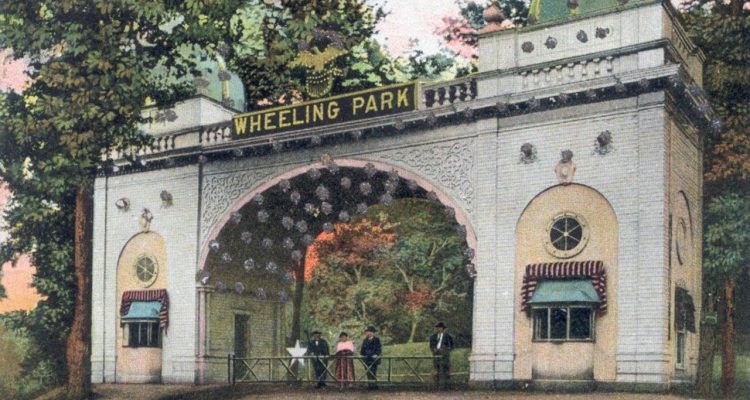They threw their poop at people.
It’s true.
It happened.
Those monkeys and their poo-flipping at visitors at Wheeling Park were a reality during several decades in the first half of the 20th Century, when they were displayed at two separate areas and housed during the winter months in a heat-controlled structure situated where the tennis bubble is today. Zoologists across the world have concluded that chimps tossing their own feces is an example of defense because they feel threatened or simply because they are bored.
“And, during those days, what we heard about the monkeys throwing their own poo was not considered complaints because it was more about humor then,” remembered Randy Worls, general manager of Wheeling and Oglebay parks from 1972 until 1999. “People found it to be funny then, but if we would have had the animal rights activists that we have today, I am sure we would have heard a lot more complaints than what we did.
“But I do believe there was a group of people who finally did go to the Wheeling Park Commission to ask them to relocate the monkeys to a zoo,” he said. “After that, the monkeys were transported in the direction of Pittsburgh in the late 1950s or during the 1960s, but the cage near the lake remained for a bunch of years after. I’m not sure if that was because they thought they would have monkeys again, but it was there with nothing in it for more than a few years.”
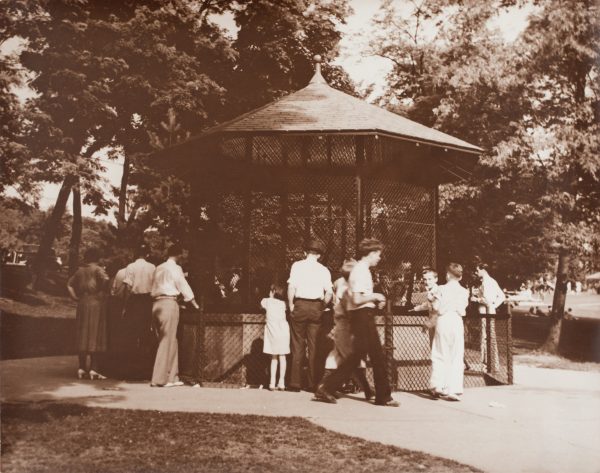
There were usually between 10 to 20 primates displayed at Wheeling Park, and although Worls remains uncertain when the chimps were added to the park’s attractions, the cages were in place when he accepted his first position with the Wheeling Park Commission in 1954.
“And the monkeys had been there for a considerable amount of time already, and it was something that one of the superintendents of that park was interested in, and he thought the people would find them interesting and entertaining,” he recalled. “At one time, there were two monkey displays with one near the old golf shop that is located near where the Stone Room is now, and another in a cubicle-like structure near the lake and the flight cage where the birds were.
“The monkey cage near the lake was on the road side of that area about halfway between the White Palace and the lake, and there was a concrete walkway that traveled past that cage and continued down to the lake,” he explained. “But the bigger display was the other one that was near where the pool was constructed to replace the old one in 1967. I do not know the exact reasons why the monkeys were there in the first place, but I do know now that it was one of the biggest reasons to go to Wheeling Park when they were there. People loved to go there and watch the monkeys.”
John Hargleroad, now the director of operations at Wheeling Park, started working for the Wheeling Park Commission in 1973 and the monkeys had been relocated by then.
“I’m pretty sure the cage near the lake was still in place at that time,” he said. “Over the years, I’ve been told that the monkeys were a popular attraction here at Wheeling Park for a lot of years, and I’ve learned that some folk used to visit with them just to try to torment them, and I have heard that the primates used to toss their feces at people for whatever reasons.
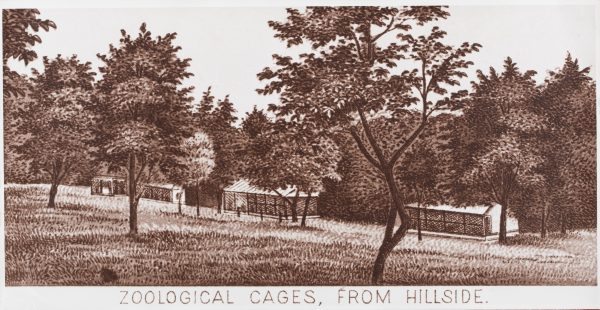
“But the monkeys were very accessible to the public, so I am sure people threw some things to them, too,” he said. “But eventually the decision was made that the primates needed to be cared for in a far better way than what they were back then. But that’s what we knew then, and that’s why most people were OK with it and enjoyed them.”
Even before the property was transitioned into a public park in 1925, animal-related attractions were available on the property until the turn of the century. Before the monkeys, and the various breeds of birds inside the large, egg-shaped flight cage, or aviary, a previous owner imported exotic animals for exhibit.
“If you really want to go back into the parks’ history back to the days before there was an amusement park at Wheeling Park that opened in 1883, a man by the name of Thomas Hornbrook had what you could consider the first zoo anywhere in this part of the country,” Worls said. “He had exotic animals that he brought in from all over the world and had them in cage-type facilities so people could walk up and see leopards, lions, and animals like what you see in our formal zoos today, but that was well over a hundred years ago.”
What most people in Wheeling recall today about the aviary are the peacocks that paced back and forth at the base of the bubble, but Worls confirmed that many breeds of birds were on display along with the peafowl. The flight cage was situated near the eastern roadway that has long been used as the exit for Wheeling Park visitors.
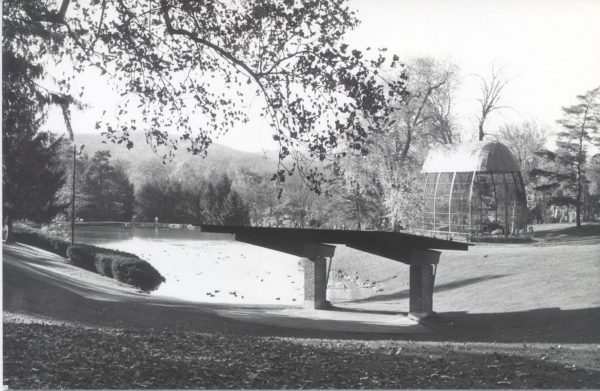
The facility was donated by Otto Schenk in 1928, and it was removed after the arrival of the 21st Century.
“Most likely more people remember the flight cage than they do the monkeys simply because of the number of years that have passed,” said Hargleroad. “But the flight cage had go, too, just like the monkey cage because of what we learned about the proper care of those birds. Plus, there were some structural issues with the flight cage at the time the decision was made to bring it down.”
Were the primates and the fowl the all-time most popular attractions in the history of Wheeling Park?
Not even close, Worls and Hargleroad agreed.
“The animals were popular for sure, but not the most popular,” Worls said. “There was a time when ballroom dancing was the big thing and they had the big bands and I can remember learning that, when the original White Palace opened, they sold around 150,000 nickle-dance tickets and each ticket gave you the right to go out on the floor and dancing for a bit. After, you had to go back and get in line again. Dancing was very big then. But the first White Palace burned to the ground after the final night of the season in October 1925. The new White Palace we know today replaced it on June 15, 1926.
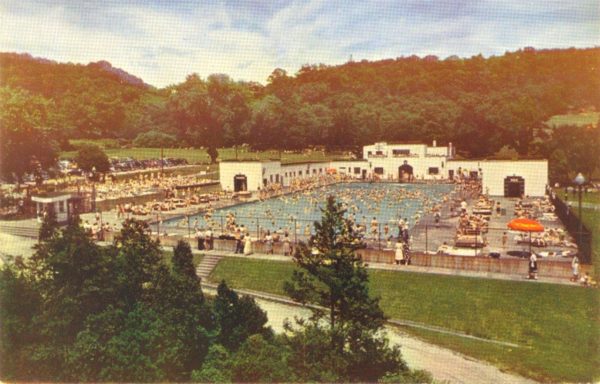
“And, for many years Wheeling Park would average between 75,000-80,000 swimmers so the pool was obviously a big attraction, especially after we put the water slide in that is still there today,” he continued. “The monkeys were certainly an attraction and they were talked about a lot when they were there, but as far as numbers are concerned I believe there are several other attractions that were more popular with more people.”
Not only did Wheeling Park feature exotic animals before the Wheeling Park Commission assumed ownership of the property, but an amusement park that featured a roller coaster, a casino, and several entertainment venues operated before most of the amenities evolved into safety risks.
“We do have photos that were taken through the years and I know people really like looking at the pictures of the old swimming pool, of the rink before the roof was erected, the roller coaster, and of the log flume that was situated at the lake many, many years ago,” Hargleroad said. “I’d say people are pretty pleased with the way the park is now but there have been a lot of changes that have taken place over the years.”
Could the members of the Wheeling Park Commission return monkeys to the Wheeling area?
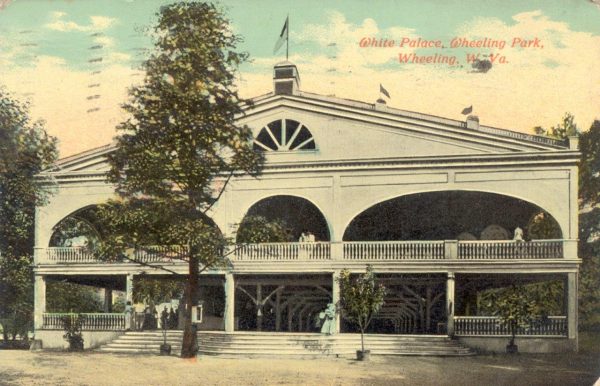
“I know they are giving some thought to bringing back monkeys to the parks at Good Zoo, but whether or not it will actually happen I am not sure,” said Worls, who has worked with the Oglebay Foundation since his retirement in 1999. “But the monkeys may be making a return visit under different conditions. A lot of changes have taken place over the years since we had the monkeys at Wheeling Park, but those changes have been for the best.”
“The monkeys were popular and I personally believe they would be popular again. When they were at Wheeling Park, one thing you had to do was get over odor of the monkeys, I definitely remember that very clearly,” he added. “The odor and the poop throwing, those were the two things that people had to put up with during their visits, but folks were fascinated by them; that’s for sure.”
(Photos provided by the Oglebay Foundation)


